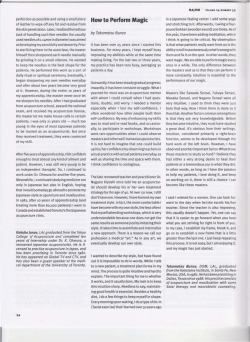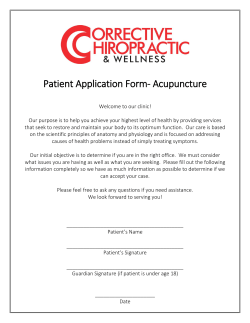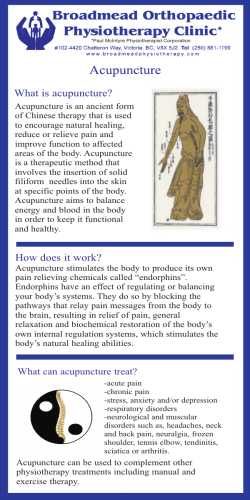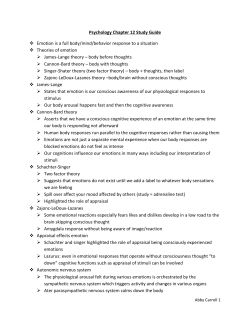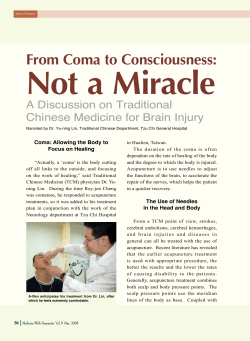
The American V69
Acupuncturist The American Volume 69 | Winter 2015 全美中医公会官方出版物 AAAOM’s Official Publication for Practitioners of Oriental Medicine アメリカ鍼灸漢方医学協会公式出版物 침술과 한의학의 미국 협회의 공식 간행물 Inside Successful Treatment of 8 cm Follicular Ovarian Cyst with Acupuncture and Chinese Patent Herbal Formulas: A Case Study The Geometry of Emotion: Healing Emotions through the Lens of Chinese Medicine Mainstream Medicine and Integrative Patient Care: Who Gets to Choose? The World Acupuncture & Integrative Medicine Conference A Translation of Wen Re Lun (温热论译文) Epidemic Warm Disease Discourses Book Review: Acupuncture for IVF and Assisted Reproduction V69 Volume 69 | Winter 2015 The American Acupuncturist is published quarterly by the American Association of Acupuncture & Oriental Medicine (AAAOM) P.O. Box 96503 #44114 Washington, DC 20090-6503 phone/fax: 866-455-7999 email [email protected] aaaomonline.org Original Research © Copyright The American Acupuncturist 2015 ISSN: 1520-7714 Resource Directory ACAOM—Accreditation Commission for Acupuncture and Oriental Medicine 14502 Greenview Drive, Suite 300B Laurel, MD 20708 phone 301-313-0855 fax 301-313-0912 acaom.org CCAOM—Council of Colleges of Acupuncture and Oriental Medicine P.O. Box 65120 Baltimore, MD 21209 phone 410-464-6040 fax 410-464-6042 ccaom.org Friends of Acupuncture P.O. Box 96503 #44114 Washington, DC 20090-6503 email: [email protected] friendsofacupuncture.org SAR—Society for Acupuncture Research 130 Cloverhurst Court Winston Salem, NC 27103 phone: 336-306-6888 acupunctureresearch.org 28 The Geometry of Emotion: Healing Emotions through the Lens of Chinese Medicine Jane Grissmer, MAc, DiplAc A Translation of Wen Re Lun (温热论译文) Epidemic Warm Disease Discourses Michael J. Jabbour, MS, LAc, HongWei Liu, PhD, LAc, and KeJian Xiao, LAc Perspectives 18 A Roundtable Discussion Mainstream Medicine and Integrative Patient Care: Who Gets to Choose? Susanne Thomas, PhD, Associate Editor Case Study 5 Successful Treatment of 8 cm Follicular Ovarian Cyst with Acupuncture and Chinese Patent Herbal Formulas: A Case Study Sariantra Kali, LAc, DAOM, MAcOM, MA Book Reviews and References 27 From the Reference Desk: Neuroanatomic and Clinical Correspondences: Acupuncture and Vagus Nerve Stimulation by Da Silva and Dorsher 43 NCCAOM—National Certification Commission of Acupuncture and Oriental Medicine 76 South Laura Street, Suite 1290 Jacksonville, FL 32202 phone 904-598-1005 fax 904-598-5001 email [email protected] nccaom.org 12 Acupuncture for IVF and Assisted Reproduction by Irina Szmelskyj and Lianne Aquilina Lee Hullender Rubin, DAOM, LAc 2 The American Acupuncturist Editorial Board 3 Letter from the Editors: Michael J. Jabbour, MS, LAc, Editor in Chief and Susanne Thomas, PhD, Associate Editor 4 AAAOM Board of Directors & Mission Statement 41 The World Acupuncture & Integrative Medicine Conference Cynthia Easter, MSAc 44 Index to Advertisers v 69 The American Acupuncturist 1 The Geometry of Emotion: Healing Emotions through the Lens of Chinese Medicine By Jane Grissmer, MAc, DiplAc Jane Grissmer, MAc, DiplAc (NCCAOM), is division chair of theory in the Masters of Acupuncture Program at the Maryland University of Integrative Health. She has been practicing and teaching acupuncture since 1980. She brings a wealth of clinical experience in acupuncture as a transformational healing art as well as ongoing scholarship in the philosophical and energetic foundations of Chinese medicine. Her publications include “When Anger Rises: Ways to Claim Anger’s Gift to Ourselves and the World.” Meridians Magazine of the Traditional Acupuncture Institute, Spring 2002. “Walking Fearward: Living into and Beyond Fear.” Meridians Magazine of the Traditional Acupuncture Institute, Winter 2002. “The Gift of Autumn: Discovering What Matters Most.” Meridians Magazine of the Traditional Acupuncture Institute, Autumn 2001. “Notes of a Qi Tender: Guides to Complementary and Alternative Medicine.” In Contemporary Chinese Medicine and Acupuncture, edited by Claire M. Cassidy. (Philadelphia: Churchill Livingstone, 2001). 12 T h e A m e r i c a n A c u p u n c t u r i s t Winter 2015 Abstract Since its inception, Chinese medicine has recognized the interconnection of the body and mind, emotions, and health. Of the fourteen originating factors of disease, seven are cited by the Nei Jing, one of the earliest recorded texts on Chinese medicine, as emotions. Despite the early recognition of emotions in the history of Chinese medicine, there has been scant literature in the field devoted to understanding the nuances within each emotion as well as the ongoing process of healing the emotional body. The aim of this paper is to provide insight into an area of Chinese medicine that is not frequently discussed, but is nevertheless extremely important for clinicians and professionals to understand. Practitioners who are drawn to assisting patients in emotional healing are more likely to find discussions of emotional nuances and the process of healing them in literature on psychology or meditative practices. In this author’s clinical experience of 35 years, chronic conditions, even if they begin on the physical level, are accompanied most often by an emotional reaction, which must also be addressed if balance is to be restored. When one works with an emotional imbalance either as an originating factor of disease or as a factor accompanying illness, knowledge of nuance and the healing process is key. How one heals and transforms a habitual emotional reaction often involves peeling through layers of thoughts, stories, beliefs, and then reframing them. “Emotions, much like waves in the ocean, exist in our background field, and they reflect our responses to the daily circumstances of life. When they flow freely and are in balance, they are what make us uniquely human, and they bring us a sense of being alive.” Chinese medical philosophy has much to offer the AOM practitioner, the biomedical practitioner as an adjunct, and the patient seeking to restore emotional balance through transformation of chronic emotional reactions. In particular, this article discusses emotions and their transformation through the lens and geometry of qi, yin/yang (life force and polarities), and virtue. From this existential perspective, through needling and coaching, our role in the treatment room ultimately is to guide patients toward greater emotional intelligence. Keywords: emotions, emotional intelligence, Oriental medicine, wave forms Background The Nei Jing cites emotions, along with climates, as a major influence on health and disease (1). Yet within Oriental medical literature, there is little attention devoted to the long-term process of emotional healing (2,3,4). We advise patients to cover their necks with a scarf in the cold, but how do we coach them to transform their chronic frustration with a life situation to a possibility instead? Many of the patients this practitioner has seen over time have healing and transformation as their goals. They imagine themselves developing greater awareness and evolving a conscious presence, one that is less reactive and more responsive to the daily movements of life. They also seek to express themselves fully into life and to be able to sustain their well-being. What happens in your treatment room when a patient asks, “How do I do it differently? My whole life it has been all or nothing” or “Why do I keep returning to the same place over and over again?” or “How can I not lose myself in a relationship?” or “How do I take a stronger stand?” Similarly, how does a patient who is prone to anger learn to respond rather than react when brushed abruptly the wrong way? How does a patient susceptible to fear learn to cultivate the capacity to confront the object of her fear? How does a patient demanding sympathetic attention learn to support herself? How does a patient who craves joy hold the flame when she is alone? How does a patient who grieves finally accept the ups and downs of life without suppressing loss and unmet expectations? Engaging with our patients over time and meeting their emotional bodies has invariably led to interacting with their personal stories, ideas, beliefs, and memories as well as the roles these play in forming the health of their energy field. Emotions as Moving Waves Emotions are no different from what is posited to be at the root of Chinese medicine: a pattern of oscillating vibration. Just like pulses and seasons, emotions are waveforms with a beginning, a midpoint, and an end. Each one is expressed in a rhythm of coming and going. Emotions, much like waves in the ocean, exist in our background field, and they reflect our responses to the daily circumstances of life. When they flow freely and are in balance, they are what make us uniquely human, and they bring us a sense of being alive. The illustration below depicts a normal waveform. It describes how a season moves through nature, how a normal pulse arrives under our fingertips, and how each of the five emotions moves through our background field when they are in balance. There are always a beginning, a midpoint or crescendo, and a leaving. Like the waves in the ocean, a waveform of emotion seeks its own completion and natural resolution. Finding its way to shore brings a sense of well-being and a smooth transition from one wave to the next, just as in the seasonal cycle. Normal rise to fullness and smooth transformation to the next wave Conceptualizing emotions as waveforms is congruent with our understanding of the nature of qi. Just like qi, emotions are geometric, having a shape or form and movement. Applying this lens to each of the five-element emotions offers insight for practitioners and patients alike. The location at which the wave is interrupted from its natural course tells us much about the distinct nature of the emotion of a particular person, the movement required to restore well-being, the most effective points to choose, the education and coaching of the patient, and the inner cultivation necessary to heal and transform the emotional body. v 69 The American Acupuncturist 13 The Geometry of Emotion: Healing Emotions through the Lens of Chinese Medicine Continuum of Emotional Expression: Our Balance Beam All of Chinese medicine rests on a balance beam of yin to yang. Emotions are no exception as they express themselves across this range—from yin to yang or from deficiency to excess. This is our balance beam, and it informs us with moment-to-moment awareness of how any of the five emotions are moving through us. An emotion that exhibits a balanced expression has the capacity to experience both ranges, left and right, simultaneously without reaction to either. This state of being an observer or of non-reactivity lies in the middle range of the continuum. When present, it naturally gives rise to the expression of the virtue or gift associated with elemental energy. Each of the five elemental energies is associated with a correspondent virtue. Wood and anger evolve to benevolence when in balance; Fire and joy to propriety; Earth and sympathy to sincerity; Metal and grief to justice; and Water and Fear to wisdom. For example, fear can be excessive and thus paralyzing on one end of the continuum, or it can be absent or denied, requiring great risk to be felt, as in bravado or recklessness, on the other end of the continuum. When experienced in the middle range, fear becomes the capacity to walk “fearward,”(5) the willingness to stand in the felt uncertainty and to take risk simultaneously…giving rise to a state of deep awareness or wisdom which corresponds to the virtue (zhi) of this emotion. This mode of viewing emotions reflects a fundamental principle of Chinese thought: that discovering balance within the natural flux of alternating poles is central to health and happiness. The character for tao (or harmonizing one’s will with nature), the Dancing One Who Knows, is a shaman moving in constant rhythm, stepping first with the left foot and then with the right. The representation of polarities and of the individual holding right and left simultaneously, while residing in the center of one’s own consciousness is an archetypal depiction of a mythological experience or an enlighten- 14 T h e A m e r i c a n A c u p u n c t u r i s t Winter 2015 ing one. This ability to maintain equilibrium in the midst of alternating currents is a cultivated state in many spiritual traditions and is crucial to sustaining the emotional state of health of the patient and well-being. Emotional Imbalance Emotional suffering or imbalance lies in those waves unable to complete their natural course. When qi or emotion no longer move through the wave but rather fixate at a point along the wave, a recurring condition or pattern in a person’s life experience emerges. Along the continuum of emotional expression, this pattern tends to occur at the polar ends of the axis with the expression of the virtue at mid-range obscured. Within the assessment language of Chinese medicine, it can be said that there are four generic waveforms representing imbalanced conditions for each of the five emotions. These waveforms of emotional expression are depicted below: (1) an excess, in which the emotion rises without the capacity to descend; (2) a collapse, in which the emotion rises and then collapses before it completes itself; (3) sputtering or stagnation, in which the emotion is caught at the crescendo, repeating itself and unable to descend or complete; and (4) an absence of the emotion, in which the emotion only barely gets off the ground. Each of the five emotions expresses itself in variation across the waveform. For instance, anger can express itself as frustration, resentment, rage, or even timidity when there is an absence. How the emotion is nuanced informs the clinician about the state of the patient’s qi and the process required to assist in its movement. “Engaging with our patients over time and meeting their emotional bodies has invariably led to interacting with their personal stories, ideas, beliefs, and memories as well as the roles these play in forming the health of their energy field.” Entrenched Thoughts Disrupt Emotional Balance In the incomplete waves shown above, our habitual reactive patterns form. Here, at the points of incompletion, we attach our personal stories, memories, and beliefs, such as blame, unloveableness, lack of fulfillment, hubris, shame, or the loss of a loved one early in life. Clustering at the points of incompletion, these learned beliefs and emotional reactions form a recurring pattern and exert a recurring effect on our qi. Resentment arises over a period of time from the polarities of unresolved blame—“my fault” versus “your fault.” Essentially, the fault lines get drawn. There is a perceived wrong and no imagined solution without an accepted apology. The effect of resentment is the stealing of one’s freedom, creativity, and self-esteem, all virtues or gifts of Wood. For each of the five elemental emotions, a rough trajectory can be charted of the incomplete waves that identify particular thought forms and beliefs that cluster around that recurrent emotion. While our stories are unique in their depth and breadth, the human condition is general, with emotional configurations that repeat themselves through time. Transformation in the Emotional Body Fritz Smith, osteopath, acupuncturist, and founder of Zero Balancing (a body work technique that works at the interface between structure and energy to release emotional patterns that no longer serve), speaks similarly of “configurations in our background field… thoughts, stories, beliefs that become concretized here—as imprints on the energy body they keep the story anchored and alive in a person’s behavior and psyche.(6)” Let us use the example of a woman growing up with a very critical mother and its impact on her emotional body through time. The woman resented her mother for the derogatory manner to which the daughter had been subjected, and likewise unconsciously berated herself in the same tone. For 64 years she carried this story, concretized without change. When she arrived for treatment, she was still resentful, angry, and without hope that this suffering could ever be removed. From the perspective of qi, the emotion of anger is sputtering, and the story as formed in her psyche will continue to disrupt her qi. The woman moves up the wave of anger, but she is unable to come to a new view. Consequently, the story continues to live in her just below the surface, waiting to be told again and again. Angry with her mother for the perceived injury, she cannot see a way through her resentment. As long as the story keeps repeating itself, her qi is caught like a rock in a stream around this imprint. Healing the emotional body requires the woman in our illustration above to finally pick up that rock and clear the stream. Old, worn ways of responding that no longer serve must be unblocked. The story needs to be acknowledged and then reframed in a life-affirming manner. Changing a story to a new one allows the wave to complete itself and qi to flow freely again. In the language of cognitive therapy, a new thought pattern is created, one that is life affirming rather than negating. How is this accomplished in Oriental medicine? In my clinical experience, I have observed three threshold conditions in which transformations occur: 1. Restore the movement of the wave of emotion. The point at which the wave is interrupted from its natural movement tells us everything about the acupuncture point to choose, the resources required for inner cultivation, the books to read, and the exercises. As acupuncturists, we restore the wave through conversation or needles or both. 2. Develop conscious awareness of the recurring reactive pattern. Continuing in the reactive pattern creates the same suffering. An “aha” moment arrives when the person develops awareness that the story being told no longer lives outside her but rather, inside. Herein, there are willingness and space for another story to form. As acupuncturists, we coach our patients to arrive at this awareness by understanding the distinctions within each emotion. 3. Choose a new response instead of an old reactive one. Over time, patients learn to respond with a restorative choice rather than a reactive response, a choice that moves the wave onward rather than reinforcing its “stuckness.” Old imprints are freed, and new ones formed. For the patient in the example above to sustain balance, she must come to the light of forgiveness for herself and her mother. In doing so, she moves beyond resentment, which lies on either end of the midpoint along the balance beam for anger, and discovers what lies in the middle range of this emotional experience: forgiveness and the virtue of the Wood element. Having lived with an obstacle v 69 The American Acupuncturist 15 The Geometry of Emotion: Healing Emotions through the Lens of Chinese Medicine of great negativity and having grown around it, she now finds a capacity for benevolence toward herself and others, much greater than she imagined, and steps into living out her true nature. Benevolence (Foregiveness) “Balancing and transforming our emotional reactions brings us to our tao and the best of who we are to the art of living.” Emotional Intelligence As practitioners working with emotions, we should hold the view of the territory while not forcing the virtue before its time. Yet our needling, coaching, and choice of points continue to aim in this direction. In the example above, Liver 1 (Great Esteem), Liver 13 (Chapter Gate), and Liver 14 (Gate of Hope) are very good choices for building esteem and a sense of possibility; Gall Bladder 41 (Foot above Tears) and Gall Bladder 15 (Head above Tears) build a capacity for choosing a new path. The patient’s points were tonified due to deficiency of the wood element and the lack of vitalization in her spirit. The order of treatment was as follows: Treatment # 1 2 Self-awareness and the capacity to choose are essential to maintaining balance in the emotional body. In the West, the term “emotional intelligence” has been coined to recognize this capacity (7). In the field of mental health, it is considered fundamental to physical health and wellness (8). Changing our background energetic field from reaction to affirmation is a learning process that evolves through time. It is, however, as important to our health as wearing a scarf around our neck in the cold. Balancing and transforming our emotional reactions brings us to our tao and the best of who we are to the art of living. Our role as acupuncturists in the long-term care of patients involves recognizing how an emotion impacts our patients’ physical health and then, along with placing needles, coaching and guiding them toward greater emotional intelligence. Treatment Points Function Liver 14 Spirit Liver 3 Source and mental calm Gall Bladder 40 Source and mental calm Liver 13 Spirit Liver 1 Wood point and mental strength Gall Bladder 15 Spirit 2. Hicks A, Hicks J. Healing your emotions. London: Thorsons; 1999. Gall Bladder 41 Wood point and mental strength 3. Larre C, Rochat de la Vallee E. The seven emotions: psychology and health in ancient China. Cambridge, England: Monkey Press; 1996. References 1. Kaptchuk T. The web that has no weaver: understanding Chinese medicine. New York: McGraw-Hill; 2000. 4. Sun SM. Thousand ducat prescriptions. China: Hong Ye Book; 1987. 5. Grissmer J. Walking “fearward”: living into and beyond fear. Meridians. 2002 Winter:7-11. 6. Smith FF. The alchemy of touch: moving towards mastery through the lens of zero balancing. Taos, (NM): Complementary Medicine Press; 2006. 7. Goleman D. Emotional intelligence: why it can matter more than IQ. New York: Bantam Books; 2005. 8. Schutz A, Nizelski S. Emotional intelligence as a factor in mental health. Chemnitz (DE): Department of Psychology, Chemnitz University of Technology; 2012. 16 T h e A m e r i c a n A c u p u n c t u r i s t Winter 2015
© Copyright 2025


